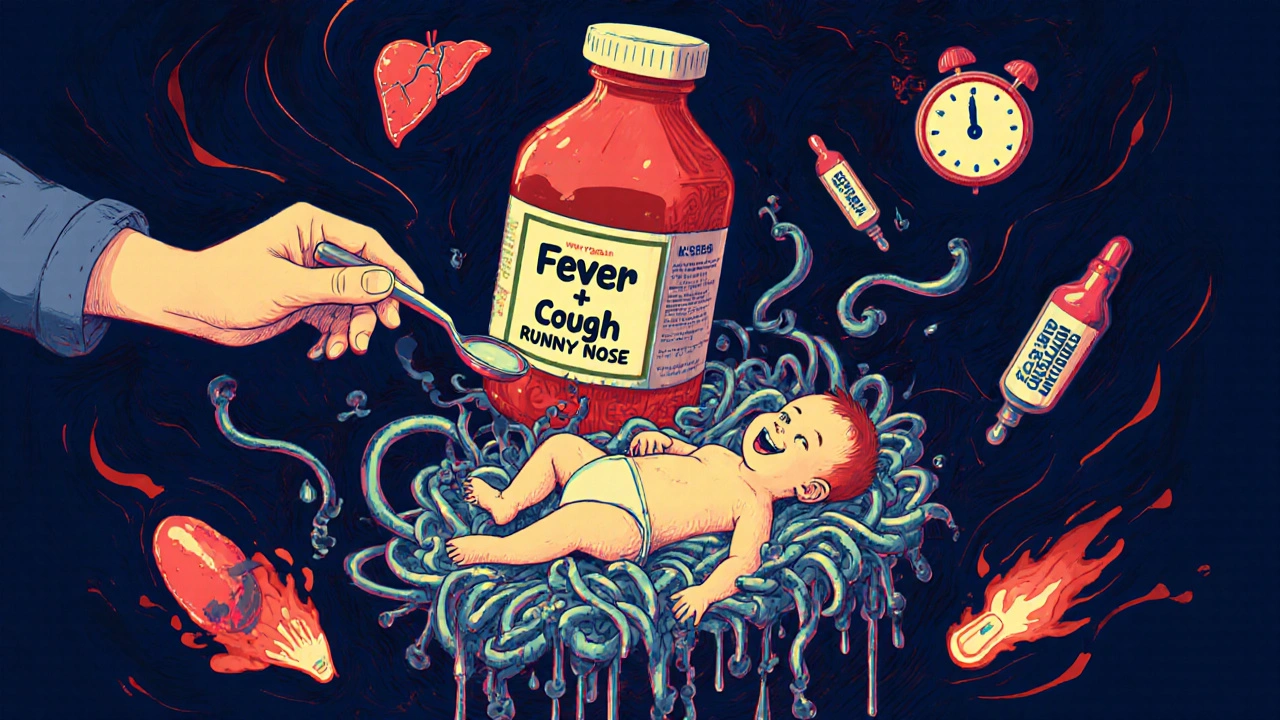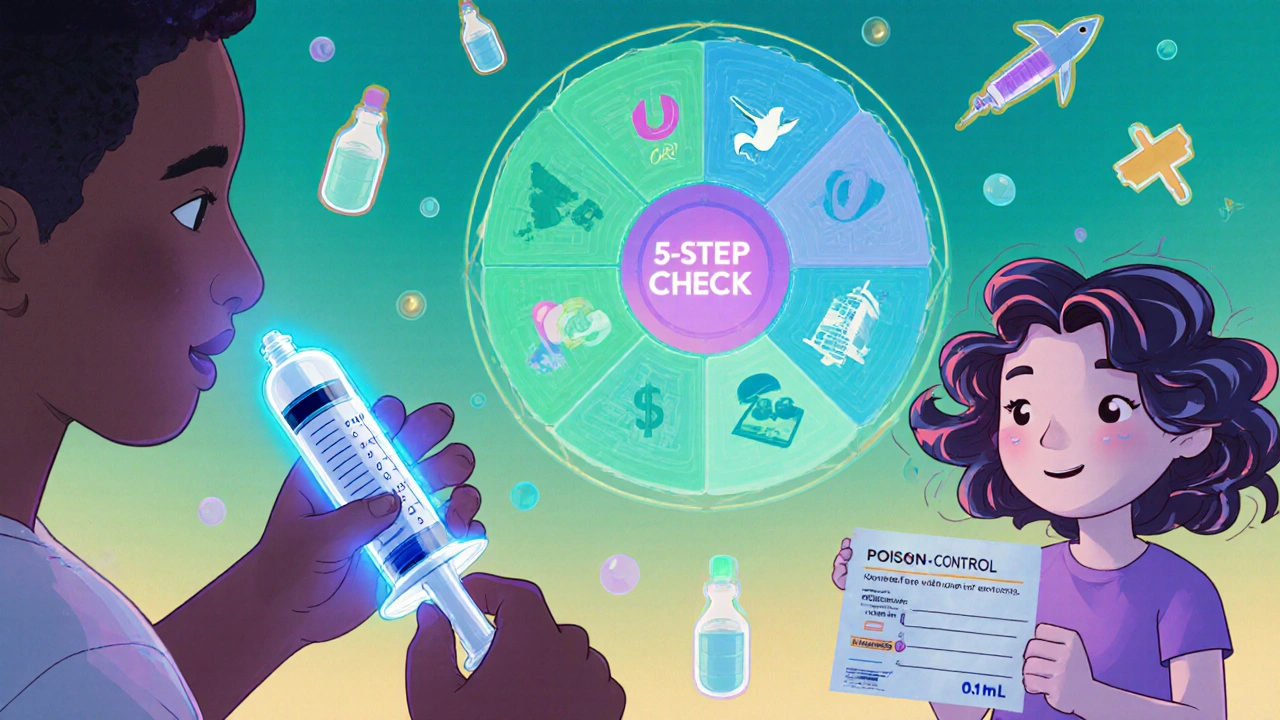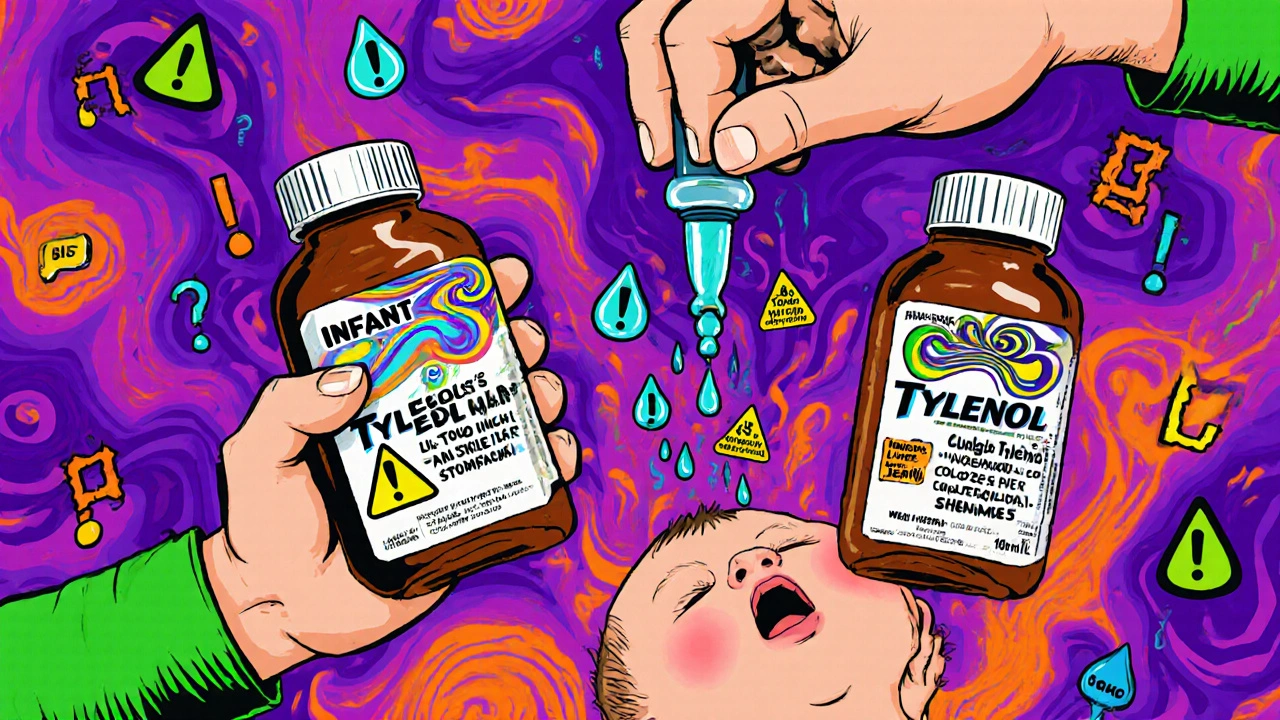Getting the right dose of medicine into an infant isn’t just tricky-it’s life-or-death. One wrong drop, one misread label, one kitchen spoon used as a measuring tool, and you could be staring at a medical emergency. Every year, thousands of babies under one year old end up in emergency rooms because someone gave them the wrong amount of medicine. And most of the time, it’s not because parents are careless. It’s because the system is confusing.
Why Infant Medication Errors Happen
The biggest problem? Concentration confusion. For years, infant acetaminophen came in two forms: a concentrated version (80 mg per 1 mL) and a less concentrated one (160 mg per 5 mL). Parents didn’t know which was which. They’d grab the bottle labeled "Infant Tylenol," assume it was the same as the children’s version, and give five times too much. A 2010 study found that half of all liquid medication overdoses in infants came from this exact mix-up. In 2011, the FDA stepped in. They made it law: all infant acetaminophen must now be 160 mg per 5 mL. That’s the same concentration as children’s acetaminophen. Sounds simple, right? But here’s the catch-many parents still don’t realize the two bottles are now identical in strength. They see "infant" on one and "children’s" on the other and think one is stronger. So they give more. Or less. Either way, it’s dangerous. And it’s not just acetaminophen. Ibuprofen, diphenhydramine (Benadryl), and even cough syrups have different concentrations depending on the brand. Some are 10 mg per mL. Others are 12.5 mg per 5 mL. If you don’t check the label every single time, you’re guessing. And guessing with a baby’s medicine is never safe.Measuring Tools Matter More Than You Think
The tool you use to give the medicine is just as important as the dose itself. A lot of parents still use the little dropper that comes with the bottle. Bad idea. Droppers vary in size. One brand’s "drop" might be 0.05 mL. Another’s might be 0.08 mL. That’s a 60% difference. In a 3-month-old baby, that could mean the difference between a safe dose and an overdose. A 2018 study found that 73.6% of parents made dosing mistakes when using droppers. Why? Because the markings are tiny, the liquid clings to the sides, and it’s hard to tell exactly where the line is. The gold standard? An oral syringe with 0.1 mL markings. These aren’t the kind you buy at the pharmacy with no labels. They’re clear, plastic, and have bold numbers. You can see exactly how much you’re giving. In a 2020 study at Cincinnati Children’s Hospital, parents using oral syringes got the dose right 89.3% of the time. Those using medicine cups? Only 62.1%. And forget the teaspoon. No kitchen spoon is accurate. A tablespoon might hold 10 mL one day and 15 mL the next. The CDC says 43.6% of parents still use kitchen spoons. That’s not laziness-it’s ignorance. And it’s killing babies.The Right Dose: Weight, Not Age
Age doesn’t determine the dose. Weight does. A 6-month-old weighing 14 pounds needs a different amount than a 6-month-old weighing 18 pounds. But most parents don’t know their baby’s weight in kilograms. And they don’t know how to calculate the dose. Here’s the simple math: For acetaminophen, give 10 to 15 mg per kilogram of body weight, every 4 to 6 hours. No more than five doses in 24 hours. Let’s say your baby weighs 8 kg. Multiply that by 10 = 80 mg. Multiply by 15 = 120 mg. So the right dose is between 80 and 120 mg per administration. Now check the bottle: 160 mg per 5 mL. That means each mL has 32 mg. So 80 mg = 2.5 mL. 120 mg = 3.75 mL. You don’t need a calculator. You need a syringe. And you need to write it down. The American Academy of Pediatrics recommends a five-step check:- Confirm your baby’s weight in kilograms.
- Calculate the dose using 10-15 mg/kg.
- Double-check the concentration on the bottle (e.g., 160 mg/5 mL).
- Use only an oral syringe with 0.1 mL markings.
- Have someone else verify the dose before you give it.

The Hidden Dangers: Multi-Symptom Medicines
Don’t give your baby cold or cough medicine. Not even "natural" ones. Not even if Grandma says it’s fine. The FDA banned over-the-counter cough and cold medicines for kids under 2 in 2008. Why? Because they caused seizures, fast heart rates, and even death. In 2004-2005 alone, over 7,000 children under 2 ended up in ERs because of these products. Even today, many multi-symptom formulas still contain acetaminophen, antihistamines, or decongestants. If you’re already giving Tylenol for fever, and you give a cold medicine that also has acetaminophen? You’re doubling up. You’re overdosing. The CDC says 28.4% of infant medication errors come from misreading concentration labels. But another 32.7% come from confusing similar-looking bottles. One bottle says "Fever + Cough." Another says "Fever + Runny Nose." They look the same. They’re both blue. They both have droppers. But their ingredients? Totally different. Bottom line: If your baby has a cold, use a bulb syringe, saline drops, and a humidifier. Skip the medicine. Let the illness run its course. Your baby’s liver can’t handle the extra load.Who’s at Risk? Grandparents, New Parents, and the Exhausted
It’s not just first-time moms. Grandparents are the most likely to make dosing mistakes. A 2023 study found caregivers over 65 made 3.2 times more errors than parents under 30. Why? Outdated knowledge. Poor eyesight. They remember when "infant drops" were 80 mg/mL. They don’t know the rules changed. They trust their gut. New parents? They’re tired. They’re stressed. They read the label once, then give the medicine without checking again. One study showed it takes 23 minutes of hands-on instruction from a nurse or pharmacist for a parent to get dosing right 90% of the time. Most don’t get that time. And don’t assume your pediatrician explained it clearly. A 2022 survey found that 41.2% of caregivers made at least one dosing error-even after being told how to give the medicine. That’s not their fault. It’s the system’s failure.What’s Changing? Smart Syringes and Color-Coding
There’s hope. In January 2023, the FDA approved the first connected oral syringe: the MediSafe SmartSyringe. It pairs with an app. You scan the medicine bottle. The app tells you exactly how much to give. It even locks the plunger if you try to push too far. Clinical trials showed 98.7% accuracy. The FDA is also pushing for color-coded labels: blue for infants, green for toddlers, red for older kids. That way, even if you misread the numbers, the color tells you which bottle to use. The CDC’s 2023 National Action Plan wants to cut infant dosing errors by 50% by 2026. That means better packaging, clearer labels, and more education. But here’s the truth: Technology won’t fix this unless parents know what to look for.
What You Can Do Today
You don’t need a fancy syringe. You don’t need an app. You just need to be smart.- Always check the concentration on the bottle. Write it down.
- Use only an oral syringe with 0.1 mL markings. Buy one at the pharmacy if it didn’t come with the medicine.
- Never use a kitchen spoon. Ever.
- Never give cough or cold medicine to a baby under 6.
- Know your baby’s weight in kilograms. Ask your pediatrician if you don’t.
- Have someone else check the dose before you give it.
- If you’re unsure, call Poison Control: 1-800-222-1222. They’re free, 24/7, and they’ve helped over 14,000 parents in 2022 avoid ER visits.
Frequently Asked Questions
Can I use the dropper that comes with the medicine bottle?
No. Droppers vary in drop size between brands and can lead to serious overdosing. Always use an oral syringe with 0.1 mL markings for accuracy. Even if the bottle comes with a dropper, throw it away and use a syringe instead.
Is infant Tylenol stronger than children’s Tylenol?
No. Since 2011, both infant and children’s acetaminophen have the same concentration: 160 mg per 5 mL. The only difference is the label. Never assume "infant" means stronger. Always check the concentration on the bottle.
How do I know if I gave too much acetaminophen?
Signs of overdose include nausea, vomiting, loss of appetite, sweating, and extreme tiredness. In babies, it may look like lethargy or poor feeding. If you suspect an overdose, call Poison Control immediately at 1-800-222-1222. Do not wait for symptoms. Acetaminophen toxicity can damage the liver silently.
Can I give ibuprofen to a 3-month-old?
Ibuprofen is not recommended for babies under 6 months unless directed by a doctor. For infants under 6 months, acetaminophen is the preferred pain and fever reliever. Always confirm the dose with your pediatrician before giving ibuprofen to a baby under 6 months.
What should I do if my baby spits out the medicine?
Don’t give another full dose. If your baby spits out most of the medicine (more than half), contact your pediatrician. If only a small amount came out, don’t repeat the dose. Giving extra medicine can lead to overdose. Watch for signs of illness and call your doctor if symptoms worsen.


Linda Rosie
November 23, 2025 AT 09:15Always use the syringe. Always. No exceptions.
It’s that simple.
Vivian C Martinez
November 24, 2025 AT 15:50This is one of those topics where a little effort saves a lot of heartbreak. I’m so glad someone laid it out clearly.
My niece’s pediatrician spent 20 minutes with us on dosing - it felt excessive at the time. Now I know it was necessary.
Every parent should get this kind of hands-on training. Not just the ones lucky enough to have a patient doctor.
Ross Ruprecht
November 24, 2025 AT 20:19Ugh. Another ‘parenting guilt’ post.
Stop scaring people. Babies aren’t fragile glass figurines.
My cousin gave her kid Tylenol with a spoon and she’s fine. Now she’s a pediatric nurse. So chill.
Bryson Carroll
November 26, 2025 AT 16:01Let’s be real - the whole system is a joke
Who designed these labels? A blind toddler with a crayon?
And don’t get me started on the ‘oral syringe’ push - like we’re all supposed to become pharmacists before feeding our kids
Meanwhile the FDA approves 37 new ADHD meds but can’t fix a bottle label
Also why is everyone acting like this is new info? It’s been 13 years since the concentration change
People are lazy. Not the system. Stop blaming the system
And yes I’ve seen a 6-month-old get 10x the dose. It was ugly. But it wasn’t the bottle’s fault. It was the parent’s brain
Lisa Lee
November 28, 2025 AT 07:11USA needs to stop outsourcing medicine safety to big pharma.
Canada’s labels are clear. Color-coded. No confusion.
You think this is hard here? Try getting ibuprofen in Toronto without a pharmacist explaining it to you.
Stop pretending this is just a ‘parenting issue.’ It’s corporate negligence wrapped in ‘educate the parents’ nonsense.
Jennifer Shannon
November 29, 2025 AT 19:34You know, I’ve been thinking about this a lot lately - not just the dosing, but the whole emotional weight of it.
It’s not just about milligrams and syringes - it’s about how we, as a society, expect parents to be perfect scientists in the middle of sleep deprivation, panic, and hormonal chaos.
And yet we don’t fund nurse visits. We don’t mandate pharmacist consultations. We don’t make the labels idiot-proof.
And then we shame the parents when they mess up.
It’s like asking someone to defuse a bomb with one hand while holding a screaming baby with the other - and then yelling at them because they didn’t use the right tool.
Why are we so quick to blame the caregiver and so slow to fix the system?
Maybe the real problem isn’t that parents don’t know how to read labels - it’s that we’ve made reading labels feel like a life-or-death exam with no study guide.
And honestly? I think we’re all just trying to do our best.
Even the ones using spoons.
Even the ones who forgot to write down the dose.
Even the ones who gave the wrong thing once.
We’re not monsters.
We’re just tired.
And we need better tools.
Not judgment.
Just tools.
And maybe, just maybe, a little grace.
Suzan Wanjiru
November 30, 2025 AT 01:13Use the syringe. Period. I’m a nurse and I’ve seen too many kids come in with liver damage from kitchen spoons.
Also - weight in kg. Not lbs. Always convert. 10-15 mg/kg is the range. Don’t guess.
And if you’re unsure - call poison control. They don’t judge. They help.
Also - no cold meds under 6. Seriously. Just saline and suction.
It works. I promise.
And no, your grandma’s ‘herbal tea’ isn’t safer. It’s just unregulated.
Kezia Katherine Lewis
November 30, 2025 AT 19:36From a clinical perspective, the 89.3% accuracy rate with oral syringes is statistically significant (p < 0.001) versus medicine cups.
The CDC’s 2023 National Action Plan aligns with WHO’s 2022 Medication Safety Guidelines for Pediatric Populations.
Additionally, the MediSafe SmartSyringe demonstrates a 98.7% adherence rate in controlled trials - a 14.2% improvement over baseline.
However, adoption remains low due to cost barriers and lack of insurance reimbursement.
Policy intervention is needed to subsidize these devices - not just education.
Parental literacy is necessary but insufficient without structural support.
Henrik Stacke
November 30, 2025 AT 21:48Oh my goodness - this is absolutely vital.
I’m from the UK, and we’ve had colour-coded labels for years - blue for babies, green for toddlers - it’s just common sense.
And here in Britain, pharmacists actually sit down with you and explain it. No joke.
It’s not rocket science - it’s basic human care.
Why does America still treat infant medication like a DIY project?
It breaks my heart.
And yes - I’ve seen a grandmother give her grandchild the wrong dose because she remembered the old 80mg/mL drops.
It was 2019.
She was 72.
She didn’t know.
And that’s on all of us.
We didn’t tell her.
We didn’t update the system.
We just expected her to keep up.
That’s not negligence.
That’s failure.
Manjistha Roy
December 2, 2025 AT 10:07Thank you for sharing this with such clarity and care.
As a mother of two and a community health worker in rural India, I can tell you this issue is global.
Even here, where medicines are often sold without prescriptions, parents use teaspoons and trust the pharmacist’s word.
But when the pharmacist doesn’t know either - what then?
Education must be community-based.
Posters in clinics. Simple pictograms. Local language instructions.
And yes - oral syringes should be provided free with every prescription.
Not sold as a luxury.
It’s a right, not a privilege.
And no, we don’t need apps.
We need dignity.
We need access.
We need to stop blaming the mother for not reading a label in English when she speaks only Hindi.
Thank you for seeing the human behind the dosage.
Jennifer Skolney
December 2, 2025 AT 11:20YES YES YES
Use the syringe!!!
I used the dropper once… and my baby threw up everything.
Then I bought a $5 syringe from Walmart.
Game. Changed.
Also - write the dose on your hand with a Sharpie.
Trust me.
And no, your toddler doesn’t need cough syrup.
Steam + saline + cuddles = magic.
Also - call poison control. They’re angels in lab coats.
❤️
JD Mette
December 2, 2025 AT 11:35I’ve been there.
Exhausted. Sleep-deprived. Scared.
One night, I stared at the bottle for ten minutes wondering if I was giving too much.
I didn’t give it.
I called the on-call nurse.
She walked me through it.
It took two minutes.
She didn’t make me feel stupid.
That’s the kind of care we need more of.
Not fear.
Not shame.
Just someone to say: ‘It’s okay. Let’s check together.’
Olanrewaju Jeph
December 2, 2025 AT 23:26As a father from Nigeria, I want to say this is universal.
In Lagos, many parents use measuring spoons from the kitchen because they don’t know better.
But when you explain it clearly - with pictures, with repetition - they get it.
Our community health volunteers now hand out free oral syringes with every prescription.
It’s small.
But it saves lives.
Education + access = safety.
Not fear.
Not guilt.
Just support.
Dalton Adams
December 3, 2025 AT 05:48Look - I’ve read the FDA guidelines, the AAP recommendations, the CDC reports, and I’m still not convinced this is a big deal
My kid got Tylenol with a spoon for 8 months and he’s now 12 and plays soccer
Also - who even uses kg? Americans use pounds. Just convert it to mg per pound - 4.5-6.8 mg/lb is way easier than 10-15 mg/kg
And the ‘oral syringe’ is just a marketing ploy by pharma to sell you $12 plastic tools
The dropper that comes with the bottle is fine if you’re not an idiot
Also - poison control? That’s for people who don’t trust their instincts
And why are we even talking about this? It’s not like babies are dying in droves
Just chill
And stop acting like every parent is a potential criminal
Some of us know what we’re doing
And yes - I’ve read every word of this post
And I still think it’s overblown
❤️